It’s probably safe to say that Sharp have, for whatever reason, slipped off the LCD radar to some extent – at least here in the UK. However, Sharp are pioneers in the field of LCD technology, and not too long ago, their distinctively designed AQUOS televisions dominated the ever-growing LCD TV market.
<!-- google_ad_client = 'pub-2887677957235196'; google_ad_slot = '4990177225'; google_ad_width = 336; google_ad_height = 280; //-->
Sharp’s B20E series proves that the Japanese manufacturer hasn’t stopped moving with the times. Highlights of this series include a 1920×1080 LCD panel of Sharp’s own making, a quoted response time of just 4ms, and 3 HDMI inputs. So, does it all gel together? To find out, today we’re going to test the Sharp LC42B20E.
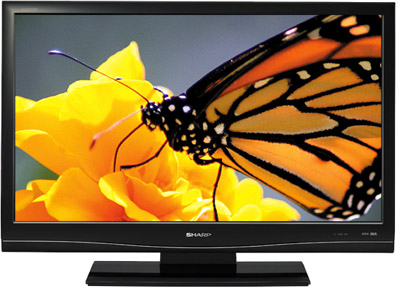
Although it’s not quite as small as Toshiba’s “Picture Frame” style bezel, the surround on Sharp’s “Slimline design” is undoubtedly very sleek, and despite succumbing to the irritating gloss-black trend, the slim border frames the screen beautifully without feeling overpowering. The bottom of the front panel features a curved “lip”, which partially covers an all-black speaker grille. Dividing these two elements is a nicely placed silver border. Hidden out of sight and out of mind to the right are power, menu, volume and channel control buttons, and side AV inputs.
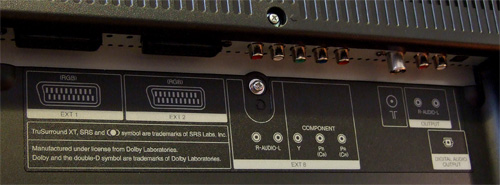
The Sharp LC42B20E includes a standard mix of both analogue and digital AV inputs. You’ll find two SCART inputs (both of which are Composite/S-Video and RGB capable), a set of Component video and stereo audio jacks, 2 HDMIs, a VGA/PC input, and on the side panel, the remaining HDMI input and S-Video/Composite inputs with accompanying audio jacks. As a new owner of an HDV camcorder, I was glad to see the side HDMI input: it’s now a standard feature on flat panel TVs, but a much-appreciated one all the same.

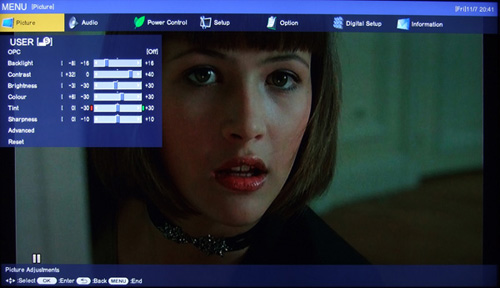
It’s little touches like this that I’ve always appreciated with Sharp’s displays: rather than going for a standard “box in the middle of the screen” approach, Sharp’s on screen menus are laid out much like a computer’s operating system, appearing as drop down menus from the top of the panel. This means that much of the viewing area is kept nice and clean, so you can see exactly what you’re doing. The day, date, and time are displayed at the top right, too, which is surprisingly handy.
There are seven menu categories to choose from, the important ones being [Picture], [Audio], [Power Control], [Setup], and [Option]. Naturally, we were most interested in the controls which altered the TV’s video display.
The Sharp LC42B20E comes set to the eye-scorching “Dynamic” mode, and to solve this problem, we had to press the AV MODE button on the remote: changing to a more sane picture mode doesn’t seem to be possible through the menus. Cycling through the various options (“Standard”, “Movie” and “Game”) eventually brought us to “User”, which already looked a lot better. From here, we were given free reign over the following controls:
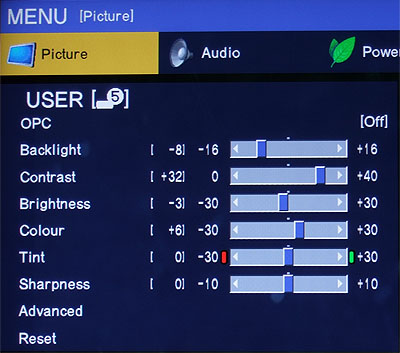
[OPC] is one of the Sharp LC42BE20E’s “Dynamic Contrast” features. It adjusts the backlight brightness on the fly, in an attempt to make blacks look blacker, and whites look whiter. We personally find the fluctuations of such systems irritating, so left this one off. Moving on, the user is given manual control over the intensity of the Backlight, Contrast, Brightness, Colour, Tint (on all sources, not just NTSC), and Sharpness. Each of these sliders defaults to the middle position, and can be taken left into the negative figures, or right into positives.
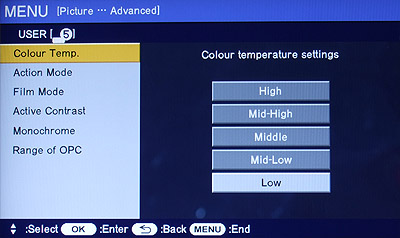
There’s more fun hiding in the [Advanced] menu. Here, the user can choose from one of five [Colour Temp.] settings, of which [Low] is the most accurate. Unsurprisingly for an uncalibrated display, each one of the Colour Temperature settings has a blue tint, and sadly, there’s no user-accessible manual control over it.
The next feature is interesting: [Action Mode], which drives the panel in a different way, which increases flicker, but decreases motion blur. If you enable this option immediately after viewing the TV in its usual flicker-free mode, you might find the sudden difference jarring, but it’s worth seeing if it’s suited to your personal preference.
The [Film Mode] option actually features two different settings. The [Standard] setting activates cadence detection, meaning that the LC42B20E LCD TV will recreate clean progressive video when fed with Film content buried inside an interlaced signal. [Advanced] goes one step further, as it uses these recovered progressive frames as a starting point, and then generates new in-between ones, creating a smoothed, video-like appearance. [Off] forces the TV into Video mode constantly, but we could rarely find a reason to use this setting. This writer left the Film Mode setting at [Standard], if only out of the perversity of programme makers trying to emulate a “film look”, only for the end viewers’ TVs to reverse it!
[Active Contrast] does just as it says, and tweaks the contrast levels in the video signal itself to create greater contrast (albeit very subtly). This option only affects the video signal, and doesn’t adjust the backlight brightness: that’s what the earlier [OPC] feature is for.
There’s also an option to turn on and off the comb filtering, [3D-Y/C], which will improve the quality of any Composite video material (such as analogue TV broadcasts, if you’re still using those). There’s also a somewhat pointless [Monochrome] option, and [Range of OPC], which allows you to fine-tune the automatic Backlight adjustment feature.
There are actually a few picture tweaks hidden in the other menus, too. the [Setup] drop-down menu has an option to choose how 4:3 content is displayed (distorted or with side bars), and [Option] has an effective [DNR] setting, allowing you to set Temporal Noise Reduction to [High], [Low], or the all-important [Off].
And where is the option for enabling 1:1 mapping for 1080i and 1080p input, you ask? It’s actually accessed by pressing the Aspect Ratio button on the remote, but don’t worry – once you’ve turned on the so-called [Dot by Dot] mode, it stays on and you can forget about it.
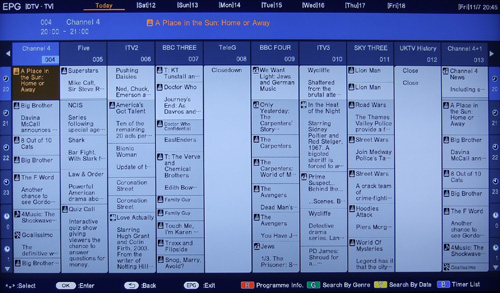
The EPG is typically the area where TVs begin to demonstrate some usability quibbles. The Sharp LC42B20E is no different, because navigating the EPG requires a little patience due to the time it takes to display a new channel’s programming information. It could sometimes take around 2 seconds to change the highlighted programme, which sounds trivial, but can become irritating quickly. Furthermore, there appears to be no way of jumping up and down a page: you’re required to scroll through one channel at a time, with delays of up to 2 seconds with each press.
On the bright side, though, the EPG is nice and crisp. Unlike many other TVs, Sharp’s implementation makes full use of the 1920×1080 panel resolution, rather than being passed through the TV’s standard-def video circuitry. Better yet, there’s three different viewing modes, one of which strongly resembles a TV listings magazine with its vertical column layout.
There’s actually another way to view EPG information: pressing the [OK] remote button while you’re watching TV. This version appears over what you’re watching without cutting out the audio, and seems to be slightly faster, but only shows the current programme, rather than a whole multi-hour grid.

Sharp’s TVs used to have delightfully odd looking remote controls that, despite looking a little strange (and we mean “sci-fi prop” strange), fitted into the hand wonderfully and worked just as well. Here, the most eccentric design features have been simplified, but the nice feeling is fully intact. The buttons are well-laid out, with directional and “OK” buttons just under the thumb, and a Volume control and MENU button nearby.
Functionality is great, too: press the AV Input select button (which is beside the channel number keys), and the TV will display a list of available inputs from which to choose from. With HDMI connections, the TV will actually read data from the connected device and label the input accordingly: I was impressed when the LC42B20E correctly recognised my PS3 and Xbox 360 consoles, and “Xbox 360” is a much more user-friendly label than “HDMI 6”.
The remote control also features buttons for enabling subtitles on Digital TV programmes, displaying programme information, and, under a flap, controls for controlling another Sharp device through the “AQUOS LINK” feature.
At times, the LC42B20E would emit a subtle background “screeching” noise. Although not visible from most viewing distances, it was audible when closer to the TV and may be of consequence to some.
Unfortunately, the cryptic service menus – which have been known to send away even the most dedicated full-time calibration experts running for the hills – prevented us from fully fine-tuning the Sharp LC42B20E (never mess with a service mode you’re unsure of). However, this does not prevent us from commenting on the pre-calibration measurements.
As with seemingly all panel displays, greyscale was heavily blue-tinted out of the box. Not surprisingly, the “Low” colour temperature option brought us closest to the desired D65 standard:
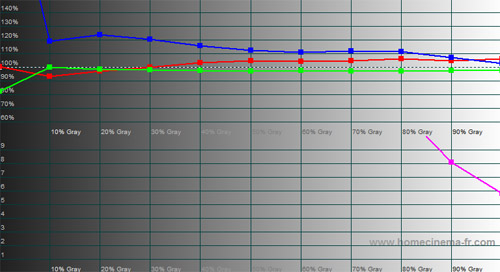 |
| RGB Tracking |
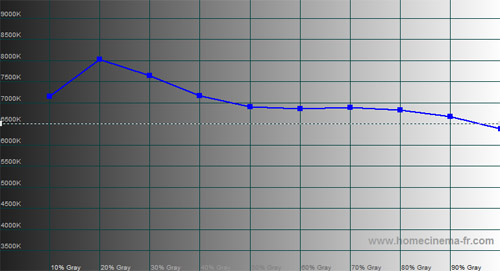 |
| CCT Chart |
Like previous Sharp LCD TVs, even with this setting, there was an excess of blue in the image until around the 80% grey point. Here, the blueness dipped, making way for a slight boost in the reds instead. We can only assume that this is designed to make the image appear psychologically brighter, whilst minimising blue tint in the brightest, most noticeable shades. If you’re used to calibrated displays, though, then you will certainly notice it.
 |
| Gamma in USER mode |
 |
| Gamma in MOVIE mode |
Earlier, we mentioned that the Sharp LC42B20E features different “AV Modes”, which come set up to produce different results. There’s more to this than meets the eye, though, because the Gamma characteristics of the MOVIE mode are different to that of the USER mode, even when both are configured with the same settings. Neither mode perfectly matched our desired target of 2.2. However, the MOVIE mode gave more consistent results, albeit closer to 2.1.
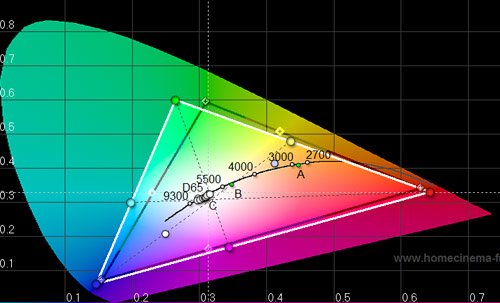 |
| CIE Chart |
The Sharp LC42B20E’s colour performance is, again, similar to previous Sharp displays. Whilst red and blue colours were fairly close to the desired Rec.709 standard, green, like on many HDTVs, was oversaturated and pushed in the direction of cyan. There is not a lot that can be done to rectify this problem, as the TV, like most, doesn’t have a Colour Management System. However, this green inaccuracy is not uncommon, and while not ideal, is far less severe a problem than similarly inaccurate reds would have been.
| Dead pixels | None |
| Screen uniformity | Banding: left side of screen brighter than right |
| Overscanning on HDMI | 0% with [Display Area] set to “Dot by Dot“ |
| Blacker than black | Passed |
| Black level | Very Good for an LCD TV |
| Black level retention | Stable if [OPC] off |
| Primary chromaticity | Average |
| Scaling | Average |
| Video mode deinterlacing | Average |
| Film mode deinterlacing | Excellent, 3:2 (60hz) and 2:2 (50hz) passed, and also 3:2 (60hz) in HD 1080i |
| Viewing angle | Average (60°) |
| Motion resolution | 250-300, rises to 550 with [Action Mode] enabled |
| Digital noise reduction | Effective |
| Sharpness | Defeatable edge enhancement |
| 1080p/24 capability (PS3) | Accepts 1080p/24 video signal; no telecine judder |
| Input lag | 0-10ms slower than a PC monitor |
| Default | 208 watts |
| Calibrated | 109 watts |
| Standby | 1 watt |
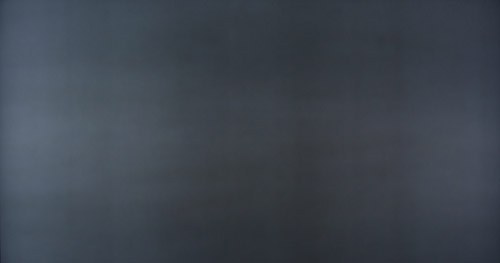
The review sample we were sent sadly suffered from a problem which has become known as “banding”, and has appeared on Sharp’s panels in the past. The easiest way to detect this was to input a 20% grey screen to the TV. What should have been a flat colour appeared slightly brighter on the left of the screen, and slightly dimmer on the right, with noticeable variations in between. The screen looked as if it were a little “dirty” as a result. Also, as is common with large LCDs, very slightly brighter patches were visible at the top and bottom left side of the panel with dark content.
The good news is that this was rarely noticeable during real world content. This said, the fact that it appears under certain conditions does prove the potential for it rearing its head (during pans in televised sports, for instance).
We measured the Sharp LC42B20E’s calibrated black level at 0.09 cd/m2. Although this is a few notches behind the levels of the newest SPVA panel LCD TVs (such as those from Toshiba, Samsung and Sony), it’s still relatively deep. Thumbs up go to Sharp for their inclusion of a backlight adjustment, to allow the panel to reach these levels (and beyond, at the expense of some brightness!).
Horizontal and Vertical on-off-on-off line patterns – as well as some real world PC usage – allowed us to confirm that the LC42B20E’s “Dot By Dot” mode works correctly, and correctly maps each pixel in a 1080-line video signal to each of the panel’s pixels, for maximum detail.
Although 720p content naturally can’t be made to perfectly match the 1080p panel, you can still enable [Just Scan] mode on such signals, to keep scaling to a minimum. This is all the more important, because the scaling in the Sharp LC42B20E isn’t the best we’ve seen.
 It’s worth noting here that Sharp’s ASV panel has an interesting design feature, which gives it a subtly different look to conventional LCDs. While most LCD TVs we’ve seen have their red, green and blue subpixels laid out in striped rows, Sharp’s ASV panel configuration has these same subpixels arranged in a triangular shape.
It’s worth noting here that Sharp’s ASV panel has an interesting design feature, which gives it a subtly different look to conventional LCDs. While most LCD TVs we’ve seen have their red, green and blue subpixels laid out in striped rows, Sharp’s ASV panel configuration has these same subpixels arranged in a triangular shape.
A colleague of mine pointed out that this pixel structure is actually quite similar to that of a CRT display. I’ve always walked by Sharp displays in stores and thought that, while still obviously LCD displays, they did possess a more “TV-like” appearance. This would appear to be the reason.
As a result of the triangular configuration, horizontal lines have an ever so slightly “serrated edge” look, which would appear to have a tiny impact on perceived picture detail – but only if you’re using the display for applications where you’re likely to be sitting right up in front of it, such as video games. It also means that Sharp’s panel has quite a distinctive look, which some viewers might well appreciate.
Using our trusty FPD Benchmark Software for Professional Blu-ray Disc, we measured the Sharp LC42B20E’s motion resolution at around 250-300 lines. This is standard for an LCD TV without 100hz functionality.
Although the Sharp LC42B20E doesn’t feature 100hz functionality as such, there is always the [Action Mode] feature. Enabling this upped the motion resolution to around 550 lines, meaning that its effect is actually similar. Better yet, it doesn’t create interpolation artefacts like 100hz systems do, instead giving the screen a slightly more CRT-like flicker. Combine this with the unusual pixel layout, and you have a display that might be that little bit easier on the eyes for CRT die-hards who, for whatever reason or another, can’t accommodate a Plasma (which is still the most “CRT TV-like” of the technologies).
The Sharp LC42B20E’s built-in video processing is a mixed bag in terms of quality. The good news is that it correctly detects and adjusts for 3:2 and 2:2 film cadences, provided the [Film Mode] option is set to “Standard”. Additionally, the LC24B20E is one display out of only a handful which correctly handles 1080i/60 film content, which is perhaps less useful given that 1080p output is standard on Blu-ray Disc players, but is very impressive all the same. The bad news is that the quality of its scaling leaves something to be desired, and does little in the way of interpolation. This means that computer-generated content and on-screen menus look brilliantly crisp and clean – as do simple test patterns – but almost any photorealistic real-world content will appear slightly pixellated. However, we’d wager that a good number of people these days will own an Upscaling DVD player, which would sidestep this issue.
That covers standard-def DVD content. However, you might then be left thinking, what of the fate of pictures from the on-board Digital TV tuner, which by design have to pass through this less-than-perfect scaling circuitry? The good news is that these don’t seem to be affected much by this shortcoming, probably because they have little in the way of fine detail to begin with.
There’s one other slight niggle that some eagle-eyed viewers might spot with computer-generated material, and that’s a tiny bit of Y/C delay, which we mention here for completeness only. Whilst using a computer, we noticed that reds were ever so slightly nudged a pixel or two too far to the left, relative to the luminance channel.

Since I’ve exhausted my supply of Blu-ray Discs that contain great films as well as great video quality, I dug a little deeper into the back catalogue and picked out Spider-Man 3, the bafflingly bizarre comic-book sequel which features a musical cookery sequence, Tobey Maguire powerwalking through Manhattan, and fortunately for the purposes of this test, a gorgeous video transfer.
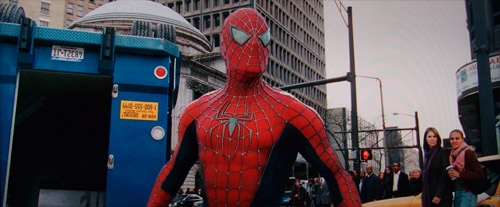
Here, the ASV panel’s unique pixel layout did give the image a very slightly dithered appearance. Whilst I would welcome this on low detail content, this particular disc has no shortage of crispness, and while sitting closer to the TV (as high definition allows you to do), I did sometimes wonder what the image would look like if the panel were to feature a more traditional pixel layout instead.
The Sharp LC42B20E also correctly handled the 24p signal, which is output from the Playstation 3, as well as many other Blu-ray Disc players. There was no judder present when using this option. Conveniently, the TV’s on screen display informs you when you’re being sent a 24hz signal, as it states the scan rate as well as the input resolution.
Over-the-air digital TV channels looked suitably good on the Sharp LC42B20E LCD TV. There appeared to be a small amount of “hidden” MPEG artefact reduction going on behind the scenes, which is subtle: given the option (which we think there should be), we’d probably choose to leave it on anyway. Programmes from the more technically competent broadcasters actually stood a chance of looking quite good, especially those originating from a film source: as the LC42B20E’s video processor correctly engages 2:2 cadence handling, none of these high-budget programmes appeared jaggy.
During testing, we found that near the beginning and end of TV programmes on certain channels (BBC Three), the screen would momentarily flash black before reappearing with the channel name and information; as if the aerial had been quickly disconnected and reconnected. Whether this is a problem with our specific review sample, aerial, or our local broadcasts, we’re not sure.
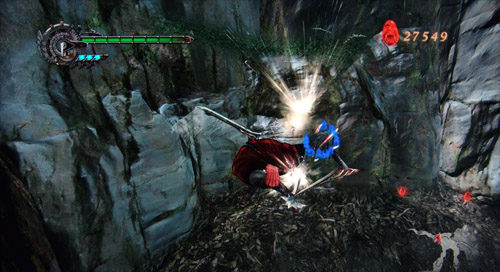
Gaming was fantastic fun on the Sharp LC42B20E, thanks in no small part to its lightning-quick response time, which we measured in the range of 0-10ms. The LCD panel’s speedy response time was beneficial too, which meant that motion blur was kept to an absolute minimum.
Not only was it free of lag, but as the video processor does not add any edge enhancement, the already crispy pictures from 360 games such as Devil May Cry 4 and Halo 3 were not altered to the point of harshness.
* Indicates issues which may be specific to our review sample
Sharp’s LC42B20E admirably delivers big-screen 1080p high definition for a price that represents excellent value for money. Although it is not a class-leading LCD display in the strictest sense of the word, it comes incredibly close in several areas. In the future, we’d like to see Sharp provide more accessible adjustment over greyscale, be it through the means of a user-accessible menu, or simply an improved hidden one.
However, in the meantime, Sharp have a display which features commendable black levels, winning usability and connectivity, and a fantastically low level of input lag, which means it earns a qualified recommendation from HDTVTest.

<!-- google_ad_client = 'pub-2887677957235196'; google_ad_slot = '0693194791'; google_ad_width = 336; google_ad_height = 280; //-->